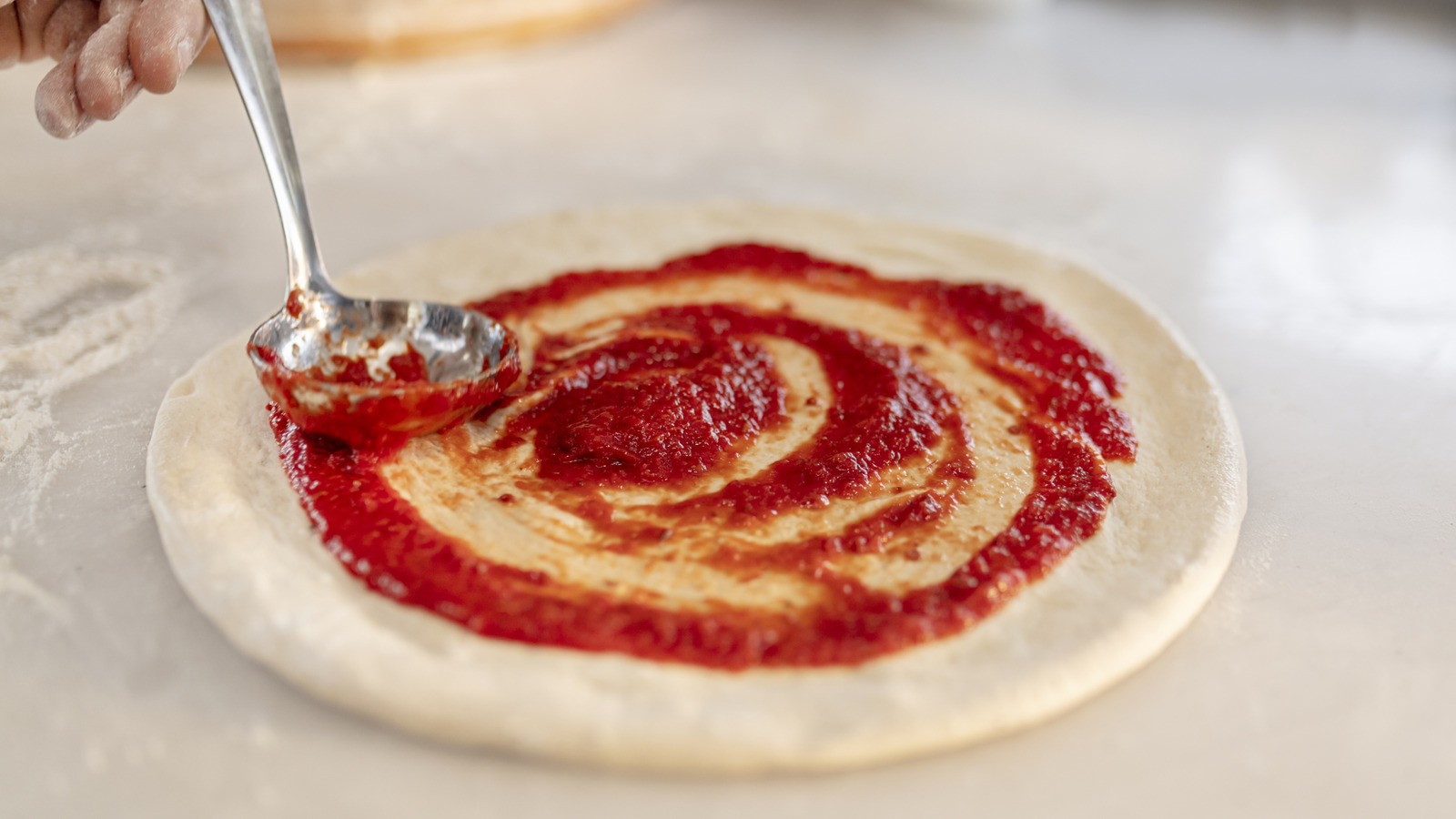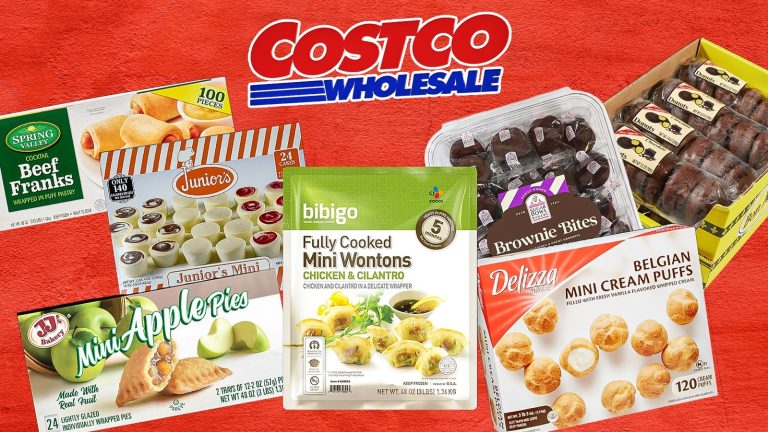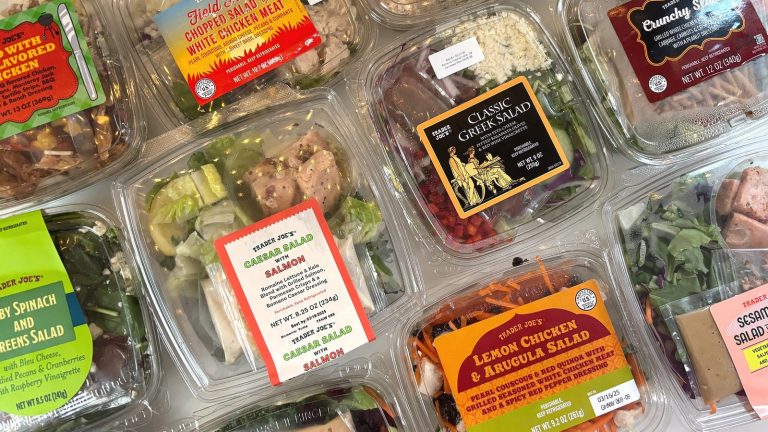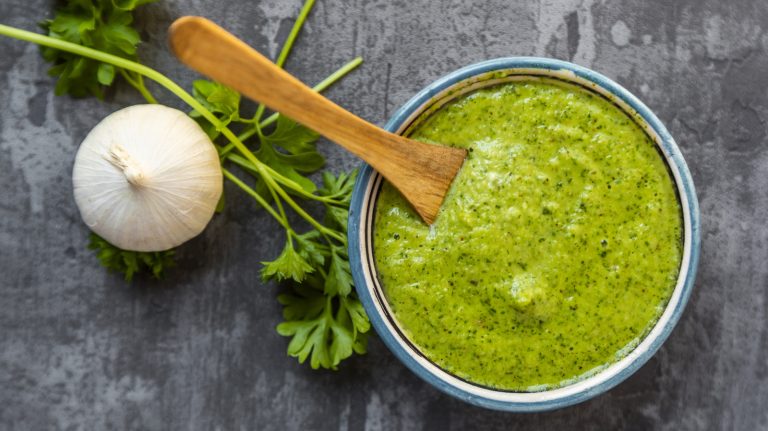We may receive a commission on purchases made from links.
Pizza is one food that is greater than the sum of its parts. Starting with a good pizza crust is essential, and adding cheese on top is a must for most pies, but if you don’t have a sauce, you don’t have a pizza. The most common pizza sauce is a classic red, which, although it looks a lot alike, is not the same as marinara. Pizza sauce often (but not always) calls for uncooked tomatoes and has a thicker, more spreadable consistency, thanks to a higher proportion of tomato paste. Besides the tomatoes, a good homemade pizza sauce also contains seasonings like basil, parsley, and red pepper flakes.
As someone who has worked professionally in a pizzeria and has a Rolodex of homemade pizza sauce recipes on stand-by, I can vouch for the fact that pizza sauce is a vehicle for flavor. And, if you’re only sticking to the basic pizza sauce formula, you’re missing out on tons of opportunity to add complexity, flavor, and deliciousness to your pie. I’ve created a list of some of the most unique and tasty sauce additions worth trying in order to offer some inspiration for your next homemade red pizza sauce.
Parmesan cheese
Wait, isn’t Parmesan cheese what you put on the pizza after it’s pulled from the oven? While many people will resort to adding a sprinkle of Parmesan to their pie, either in tandem with the classic mozzarella or on its own — in the case of a classic tomato pie — you could also add it directly into your pizza sauce.
Parmesan is a versatile cheese because it’s incredibly salty and savory, yet doesn’t have a fatty or greasy flavor. So, it will impart all of these flavor subtleties into your sauce. When I’m making pizza sauce at home, I like to add a little bit of fresh Parmesan to the pizza sauce as it’s cooking away on the stove — no more than a ¼ cup for a large pot of sauce. However, you could also infuse a salty flavor and reduce your kitchen waste by popping in a leftover Parmesan rind into your sauce and straining it out when you’re ready to sauce your pie. The flavors will seep out of the rind and into the sauce, elevating its flavor and its saltiness.
Red wine
One of my favorite pizzas at the restaurant where I worked was a fun take on an eggplant Parmesan. It utilized a beautiful, flavorful, and tannin-rich red wine sauce, which acted as the perfect foil to the thinly-sliced eggplant, molten cheese, and sprinkle of breadcrumbs on top of it.
If you are a big fan of the flavor of red wine, chances are that you would probably appreciate it in a pizza sauce. Red wine adds a unique robustness to sauce, and if you let it cook down on the stove, you will concentrate that subtle floral flavor even more. I recommend adding a splash of wine both to deglaze your pan after your aromatics have finished cooking and again after you add the tomatoes. Some of the alcohol content will inevitably cook off, but you don’t want to be too heavy-handed with your pour that you make the whole thing taste like a bottle of cab.
Fennel seeds
Fennel is a very, very acquired taste that not everyone will love. But, if you enjoy sausages stuffed with this licorice-tasting seed, then you’ll want to try adding some to your pizza sauce.
When you bite into one of these seeds, your whole mouth will be overcome with an anise-y bite. As such, you need to be careful about how many fennel seeds you add to your homemade pizza sauce. While it can seem like you can never have enough of other common pizza sauce spices, like oregano, basil, and rosemary, adding too much fennel will disrupt the consistency and flavor of your sauce.
I personally love fennel and don’t mind biting into a pod now and again. But if you prefer a silky smooth tomato sauce, you’re going to want to opt for a teaspoon or so of ground fennel. This ground spice will more readily infuse into your sauce, and its flavor isn’t as potent as that of the whole seeds.
Canned chipotles in adobo
There are a lot of items in the canned goods aisle that can give your pizza sauce a unique edge. Although it might seem a bit odd to take a stroll through the Tex-Mex portion of the store for a decidedly Italian dish, you won’t regret adding a can of chipotles in adobo to your cart for your next batch of homemade pizza sauce. These canned peppers have a very expressive flavor. Not only do you have a subtle, almost caramelized sweetness at play, but there’s also a considerable amount of heat that prickles your taste buds. Sure, it can be overwhelming to eat it straight from the can, but when you add the peppers to a pizza sauce, you’ll find that their flavor mellows out and infuses with the tomato base, as well as the Italian spices.
You don’t need a whole lot of the chipotle to flavor your pizza sauce either. Cook down about a tablespoon of the chipotles with the rest of your pizza sauce. If you prefer a smoother sauce, you may want to use an immersion blender to puree the chipotles into the sauce and better distribute their flavor.
Sun-dried tomatoes
Pizza sauce is already tomato-y enough, but if you want to channel a sweeter flavor, you’re going to want to pick up yet another tomato product: sun-dried tomatoes.
This is one ingredient that you can use for fresh pizza sauce or cooked pizza sauce. Simply pull a couple of the tomatoes from the jar, plop them into your sauce, and wait for that sweet, slightly caramelized flavor to infuse with the rest of the ingredients. You’ll want to puree your mixture — either in a food processor for a fresh pizza sauce or with an immersion blender for one made on the stovetop — to ensure that your sun-dried fruit is well distributed throughout the sauce. The robustly flavored sauce can work with almost any toppings, but it’s especially delicious when paired with a cheese that can combat that sweetness and complexity — like feta or goat cheese.
Harissa
Harissa is one of my favorite spices to work with, but I won’t blame you if you’ve never heard of it. Not only can the North African spice blend add a bold, smoky flavor to roasted veggies, but it can also stand up to the acidic flavor of the tomatoes and offer your pizza sauce a unique warmth. Harissa is made with roasted red chile peppers, as well as punchy spices like paprika, garlic, and caraway seeds. From there, it’s turned into a paste with lemon juice and olive oil.
You can add a little of the paste to your pizza sauce, but since it is quite spicy, you’ll want to avoid being too heavy-handed with it; a couple of tablespoons of harissa paste should suffice, and you can always add more if you like things a little spicier. Another important thing to note is that harissa likes to be the center of attention, so stick to basic and complementary topping pairings for your harissa-based sauce, like shredded chicken, smoked mozzarella, and cauliflower.
Curry powder
Curry-flavored pizza sauce is admittedly a little bit out there, but as long as you’re okay coloring outside the lines when it comes to pizza, you may appreciate this cultural mashup more than you’d think. “Curry” is a term that encompasses a broad swath of spices, from turmeric and coriander to black pepper and black salt. So, you’ll want to make sure you read the label when you select one for your pizza sauce.
I, for one, am a big fan of Penzy’s sweet curry in a pizza sauce. The heat isn’t too domineering, and the cumin, fenugreek, and cayenne tickle my sinus when I eat it. I’ll only add a couple of teaspoons of the curry to the pizza sauce, mix it well, and wait for the complex bouquet of aromas and flavors to intermingle with the sauce’s other components. This curry-spiced pizza sauce is an excellent pairing for proteins like chicken, thinly-sliced potatoes, and/or seasoned cauliflower.
Calabrian chiles
Calabrian chiles might not be an ingredient you keep stocked in your pantry, but after this, you might be inclined to pick up a jar of them. It’s one of Bobby Flay’s favorite ingredients to use, and it turns out that it makes an excellent, spicy addition to a pizza sauce too.
The chiles are often packed into jars with oil, though you can also find a paste version of the product. The peppers are fruity and floral, balanced out with a beautiful warmth that will elevate your sauce and add an arrabita-style spin to it. Start with adding one or two chiles to your sauce, tasting as you go. The fiery chiles are a great base for a fatty meat topping, like crumbled sausage, or you can counteract some of that heat by playing with umami-rich or sweet toppings, like mushrooms and roasted red peppers.
Balsamic vinegar
Tomatoes tend to be quite acidic, so you have to be careful when you’re adding acidic ingredients, like balsamic vinegar, to your pizza sauce. But, if you manage to get the flavor chemistry right, you’ll be glad that you added this slightly sweet and tangy condiment to your pizza sauce. It brings flavor nuances to pizza sauce in a way that other ingredients don’t. A balsamic-spiked sauce is a great pairing for thinly-sliced veggies, like tomatoes, sweet potatoes, and even artichokes.
Balsamic vinegar offers a slightly sour profile, along with sweet notes, so I would recommend adding about a tablespoon of it to your sauce before you taste it and then adding more as needed. Since it is sweet, you may also want to hold off on adding the sugar until you taste the sauce to see if it is sweet enough without it.
Miso paste
I am an absolute fiend for miso paste; it’s an ingredient I find myself almost instinctively adding to things like cookies and caramel sauce. This funky, fermented soybean paste adds both salt and umami to any dish, which makes it just as much of a culinary asset for sweet recipes as for savory ones. This ingredient will take your pizza sauce to the next level because its umami notes will amplify similar flavors in the tomato paste.
Miso paste is, admittedly, salty. So, you’ll want to hold off on adding any additional savory or salty components to your pizza sauce until you see what it tastes like with the paste added. White and yellow miso are the two milder varieties; red miso has a more concentrated flavor. If you are a miso novice, I would recommend sticking to a milder miso for your recipe; only add a tablespoon or two to start.
Caramelized onions
Caramelized onions are an ingredient that you’re more likely to top your pizza with than add to your sauce. But, it turns out that this slow-cooked allium can introduce a burst of sweet, caramel flavor to your sauce and reduce the need to add any extra sugar to it.
The key to adding this ingredient to your sauce is making sure that the onions are fully caramelized; you can’t just cook them on the stove for 10 minutes, toss them in, and hope for the best. Properly caramelizing onions is critical to pulling out those sweet and complex flavors. Once your onions are adequately browned, limp, and sweet, you can add them to your sauce, pureeing them into the mixture when the time comes. This slightly sweet sauce is an excellent base for meaty pizzas, like ones topped with flavorful sausage and bacon, as well as anything in the fungi family.
Black garlic
Black garlic is an incredibly beautiful ingredient that, despite its unique flavor, has yet to enter the cooking mainstream. Whereas regular garlic has a spicy and subtle burn, black garlic boasts more of a sweet and umami flavor with notes of molasses and dates. The allium undergoes the Maillard reaction as it is cured (not fermented, as some people may think), which renders its texture date-like and pasty.
Black garlic’s stickiness can make it difficult to work with, especially when chopping is involved. However, I still prefer to work with the whole cloves over powdered black garlic because the former’s flavor is robust. I’ll usually add a whole clove of black garlic to the sauce and hit it with the immersion blender before ladling it on my pie. However, if you don’t own an immersion blender, you can also source out black garlic paste, which will more seamlessly integrate into your sauce and offer the same bold punch of flavor as the whole cloves.
Anchovy paste
How you feel about adding anchovies to your sauce will likely depend on how you feel about placing this tiny, tinned fish on your pizza. I personally find that adding anchovies to the sauce is more approachable than adding them to the pizza, seeing as how you don’t have to bite through the fleshy fish when you’re eating a slice. Anchovy paste, a tubed food product made with the fish, oil, and salt, is easy to disperse into your sauce, as well as into things like homemade Caesar salad dressing. Another benefit of using the paste over the tinned fish is that it keeps for longer, meaning you don’t have to find creative ways to use up all of the fillets in the tin before they go bad.
You only need to add anywhere from a teaspoon to a tablespoon of the anchovy paste to your sauce to impart a deeply savory and umami flavor on it. That being said, anchovies are quite salty, so avoid adding too much extra salt on top of the paste. Anchovy paste-infused pizza sauce pairs well with an array of classic pizzas, from a simple Margherita to a New Haven-style tomato pie.
If you are someone who is wary about adding anchovies to your pizza sauce, try starting with fish sauce. This thin liquid is a great substitute for anchovies, and you’ll only need to add a tablespoon or two of it to taste its salty and savory effects.
Lemon zest
Lemon zest is an excellent ingredient to add to your pizza sauce after it’s finished cooking, especially if you’re making a seafood-inspired white pie with scallops or a vegetable-forward pie with a pesto sauce base. But, it turns out that lemon zest can also be used to help balance flavors in your red pizza sauce by introducing a slight and unexpected pop of acidity.
I like to add a little bit of lemon zest (or lemon juice, which I always keep a bottle of on hand) to the sauce to help sharpen its flavors. The lemon pairs well with the tomatoes, and it can also be used to correct a batch that you added a little too much sugar or sweetener to. I usually cap at half a lemon’s zest, as I don’t want to overtake the sauce with the citrus’ acidity. This zesty sauce is a great pairing for pies with rich and heavy toppings, like ricotta and sausage, or vegetarian pies that need a little acidic pop, like ones topped with roasted red peppers or artichokes.
Maple syrup
Sugar is a common addition to pizza sauce because it balances out the acidity in the tomatoes. But the next time you need to sweeten up your pizza sauce, consider reaching for maple syrup instead of white sugar.
Maple syrup has oaky undertones that will add a unique edge to your sauce and make it more multi-dimensional than regular sugar would. You can add it to both cooked and uncooked pizza sauce recipes. Start with one teaspoon of the sweetener, and taste and add more as needed. I also like to pair maple syrup and a dash — emphasis on dash — of hot sauce to create a hot honey-like effect. The prickly bite of the hot sauce is an excellent foil to the sweet maple. A maple-infused pizza sauce would be an excellent pairing with chopped bacon, sausage, or ricotta.
Butter
Olive oil is an essential ingredient in Italian cooking, but it turns out it’s not the only fat that you should add to your pizza sauce. If you want to make your sauce extra rich and flavorful, consider adding a pat of butter as well. The butter will help mellow out an especially acidic batch of tomatoes and will offer your sauce a richer mouthfeel.
The olive oil is still a great base sauteeing your aromatics in, so you won’t want to swap it out entirely. You can add the butter to your pot with the aromatics and the olive oil; as long as it’s not cooked at too high a temperature, you shouldn’t have to worry about it smoking, especially since it’s mixed with butter. Though if you prefer the taste of the butter to be more pronounced, you can add a couple of pats to your sauce after you’ve mixed in the tomatoes and right before you’re about to top your pizza crust.





